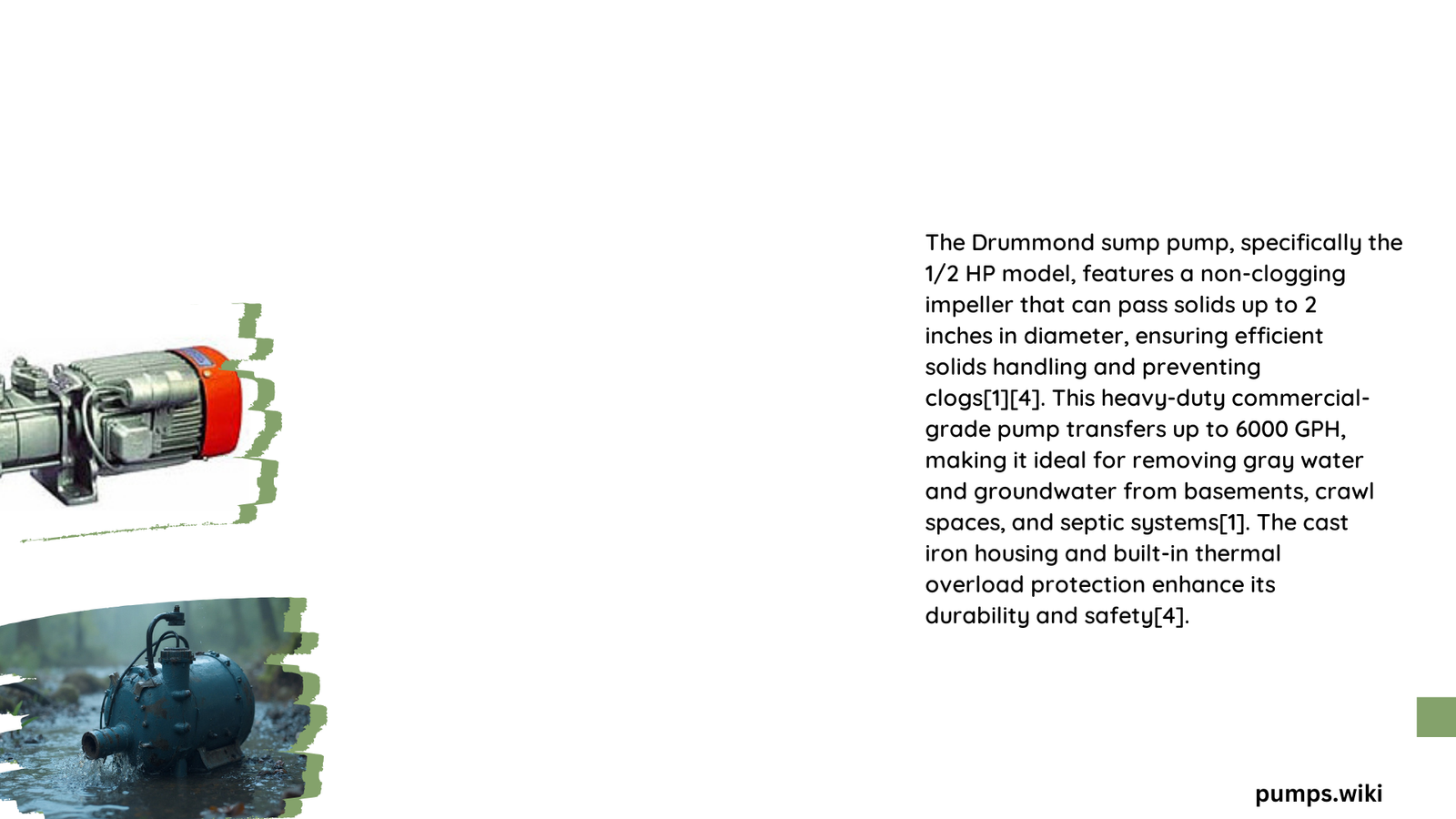The Drummond sump pump is designed for efficient water removal, capable of handling small solids and debris. With a flow rate of 3000 gallons per hour for the 1/4 HP model, it’s suitable for various applications. While not specifically designed for large solids, its strainer helps manage small particles in groundwater and gray water. This guide explores the pump’s capabilities, installation process, and maintenance requirements for optimal solids handling performance.
What are the Specifications of the Drummond Sump Pump?
The Drummond sump pump comes with specific features that contribute to its solids handling capabilities:
- Horsepower: 1/4 HP
- Flow Rate: 3000 gallons per hour (GPH)
- Maximum Head Lift: 26 feet at zero flow
- Solids Handling: Designed for groundwater and gray water, including small debris and sediment
- Strainer: Included for filtering larger debris
- Maximum Water Temperature: 77°F (25°C)
How Does the Pump Handle Solids?

The Drummond sump pump’s solids handling capability is primarily focused on managing small particles and debris commonly found in groundwater and gray water. Here’s how it manages solids:
- Strainer Filtration: The included strainer acts as the first line of defense, preventing larger debris from entering the pump.
- Impeller Design: While not explicitly stated, the pump’s impeller is likely designed to handle small solids without clogging.
- Flow Rate: The high flow rate of 3000 GPH helps move small solids through the pump efficiently.
It’s important to note that this pump is not designed for handling large solids or non-water fluids like fuels or cleaning solutions.
What is the Step-by-Step Installation Process?
Proper installation is crucial for optimal solids handling. Follow these steps:
- Choose Location: Place the pump in a sump pit or low spot where water accumulates.
- Connect Hose: Attach a 3/4 inch garden hose to the discharge port.
- Install Strainer: For deeper installations, attach the strainer to filter debris.
- Secure Pump: Use the provided base to stabilize the pump and prevent debris entry.
- Electrical Connection: Plug into a GFI outlet for safe operation.
- Test: Ensure automatic operation when water is present and shut-off when water level drops to 3/8 inch.
Always check local building codes and regulations before installation.
What are the Maintenance Requirements for Optimal Solids Handling?
To maintain the pump’s solids handling efficiency:
- Regular Inspections: Check the pump, strainer, and hose connections frequently for debris accumulation.
- Clean Strainer: Remove and clean the strainer regularly to prevent clogging.
- Check Electrical Connections: Ensure the GFI outlet and power cord are in good condition.
- Monitor Performance: Watch for any changes in pump efficiency, which could indicate solids-related issues.
How to Troubleshoot Common Solids Handling Issues?
If you encounter problems related to solids handling, try these troubleshooting steps:
- Clogged Strainer:
- Remove and clean the strainer
-
Check for any debris accumulation around the pump base
-
Reduced Flow Rate:
- Inspect the discharge hose for blockages
-
Clean the pump intake and impeller area
-
Pump Failure:
- Verify electrical connections
- Ensure the pump isn’t operating beyond its temperature range
- Check for any large solids that may have entered the pump
What are the Limitations of the Drummond Sump Pump’s Solids Handling?
Understanding the pump’s limitations is crucial:
- Solids Size: Not designed for large solids; use with the provided strainer
- Fluid Types: Only suitable for water; not for fuels or cleaning fluids
- Temperature: Water temperature should not exceed 77°F (25°C)
- Continuous Operation: Not designed for constant use with high solid content
How Does the Drummond Sump Pump Compare to Other Models in Solids Handling?
While specific comparisons aren’t provided in the available information, here’s a general comparison:
| Feature | Drummond Sump Pump | Typical Sump Pumps |
|---|---|---|
| Horsepower | 1/4 HP | Varies (1/3 HP to 1/2 HP common) |
| Flow Rate | 3000 GPH | 2000-4000 GPH range |
| Solids Handling | Small debris, sediment | Varies by model |
| Strainer | Included | Not always included |
| Price Range | Generally affordable | Wide range |
What are the Best Practices for Maximizing Solids Handling Efficiency?
To get the most out of your Drummond sump pump’s solids handling capability:
- Regular Maintenance: Clean the pump and strainer frequently
- Proper Installation: Ensure the pump is correctly positioned and secured
- Use the Strainer: Always use the provided strainer to filter larger debris
- Monitor Water Quality: Be aware of the types of solids entering the pump
- Avoid Overworking: Don’t use the pump for applications beyond its design specifications
By following these guidelines, you can ensure your Drummond sump pump effectively handles solids within its designed capabilities, providing reliable performance for your water removal needs.
